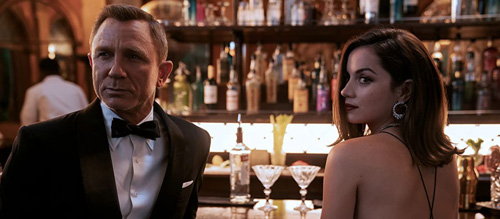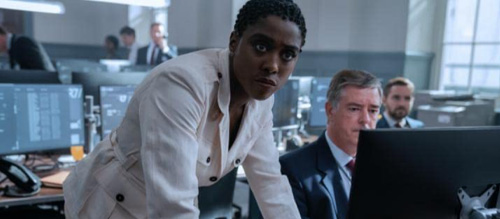No Time to Die (2021) Review

No Time to Die (2021)
Director: Cary Joji Fukunaga
Screenwriters: Neal Purvis, Robert Wade, Cary Joji Fukunaga, Phoebe Waller-Bridge
Starring: Daniel Craig, Rami Malek, Léa Seydoux, Lashana Lynch, Ralph Fiennes, Christoph Waltz, Ben Whishaw, Naomie Harris, Jeffrey Wright, Billy Magnussen, Ana de Armas, David Dencik, Rory Kinnear
Daniel Craig’s last hurrah as James Bond has been a long time coming. Between Danny Boyle departing the project due to the old “creative differences” chestnut, Craig’s injury during filming and the many release reschedules as a result of the Coronavirus Pandemic, the release of the latest Bond film has taken as long as the last long break in the franchise, between Licence to Kill in 1989 and Goldeneye in 1995. So, after all this patient waiting, does No Time to Die justify one of the longest build-ups in blockbuster history? It probably depends on what sized screen you’re watching it on (IMAX is highly recommended).
James Bond (Daniel Craig) is forced out of his happy early retirement with Madeleine Swann (Léa Seydoux) by the re-emergence of SPECTRE and the plans of terrorist Safin (Rami Malek) to deploy a deadly biological weapon. But can Bond, with the help of agents from MI6 and the CIA, who both seem increasingly unfit for purpose against more nebulous world threats, save everything and everyone that is important to him one last time?
No Time to Die, at least in terms of sheer scale, spectacle and ambition, is a truly grand finale for Daniel Craig’s tenure as James Bond. It’s also the longest Bond film by some margin, but thankfully it’s engaging enough to not feel like it. Cary Fukunaga’s directorial vision is striking from the film’s very first slasher movie-inflected scene, and the standard is only raised by a propulsive extended action sequence in Italy that precedes the dazzling credits sequence accompanied by Billy Eilish’s earworm of a theme song. Most of the action scenes that follow, especially the late stage close-quarters shootout between Bond and an army of henchmen in a stairwell, all have a pleasing rhythm aided by Tom Cross and Elliot Graham’s punchy editing and don’t shy away from the necessary brutality of Bond’s actions. Action fans will doubtless be satisfied by what’s on display, but you do start to run into some problems if you look any deeper.
The Craig Bond movies have suffered from tonal inconsistencies ever since they started giving him one-liners in Skyfall. These are some of the darkest and most violent entries in nearly 60 years of spy movies, and yet Craig is now doing jarring Roger Moore puns and some of the spy shop talk scenes are liable to make you double-take like that pigeon in Moonraker, notably the one that transitions straight from a deathly serious discussion of a world-threatening programmable virus to a conversation about what might be the best way to hack into a bionic eye.

Aside from Craig, who fully completes Bond’s transformation from blunt instrument to a fully-rounded, fallible and emotional human being, it is the women in this Bond film that steal the show, and it’s about damn time.
Incredibly, Léa Seydoux as Madeleine is the first “Bond Girl” to carry over from one film to another in the franchise’s history. Recruiting Phoebe Waller-Bridge on co-scripting duties seems to have helped no end as Madeleine gets some real depth and an arc continued from Spectre, her resilience developed from being the daughter of an amoral man with a lot of enemies, but never letting the many horrors she witnesses change her fundamentally good and caring nature. Having Bond’s back in the action scenes is the hyper-competent and professional 00 agent Nomi (Lashana Lynch) – surely destined for a TV spinoff if EON Productions choose to go down that route with Amazon – and also Paloma (Ana de Armas), an enthusiastic but nervy new CIA recruit who proves a real asset to Bond in a fight. It’s only really Moneypenny (Naomie Harris) who gets a bit of a short shrift, still largely being confined to typing duties after she accidentally shot Bond two films ago.
Poet, writer and academic Jen Campbell has talked a lot in her YouTube video series about disfigurement and villainy in popular culture, and it is a debate that has certainly gained traction in recent years. Whatever Ian Fleming and others did in their books, and however long-standing a character trope for the Bond movies and other visual media it is, we need to stop equating physical differences with evil. It’s 2021. There’s not one but three different baddies in No Time to Die carrying on this tired and frankly quite gross convention.
You could almost forgive the filmmakers for making the characters visually distinctive to match a memorable performance, but Safin is such a first-base Bond villain (once his need for personal vengeance is satisfied he falls back on a vaguely defined master plan involving killing a lot of people for reasons), and Malek’s generically foreign accent is so thick you’re doing well if you haven’t missed half his dialogue. It’s nice for Bond fans to be treated to the sight of an honest-to-goodness villain lair on an island again, but quite what all his hazmat-suited lackeys are actually doing in the background is anybody’s guess.
Speaking of accents and stereotypes, David Dencik’s plot-driving Russian scientist Obruchev is the most cartoonish exaggerated role in a Bond film since Alan Cumming’s Soviet hacker Boris in Goldeneye. At times his line delivery stops just short of Borat and the character oscillates between exposition dumping and acting as a moustachioed MacGuffin. Continuing this somewhat archaic and backwards look at the world as it stands today, there is also a bizarre moment towards the end of the film that presupposes continuing British military might on the global stage which is frankly a fantasy, but then again that’s what Bond has always been.
For all its inconsistencies and a few noticeable stumbles, No Time to Die builds to a pretty great, powerful, almost operatic finale that brings world-ending stakes back down to the most human and relatable level. With the help of assured direction, solid supporting performances and eye-popping action set-pieces, Daniel Craig goes out on an overall high by the standards of the wider James Bond series, even if some of his earlier outings were more consistent in their execution.
16/24
Recommended for you: Every James Bond 007 Movie Ranked

